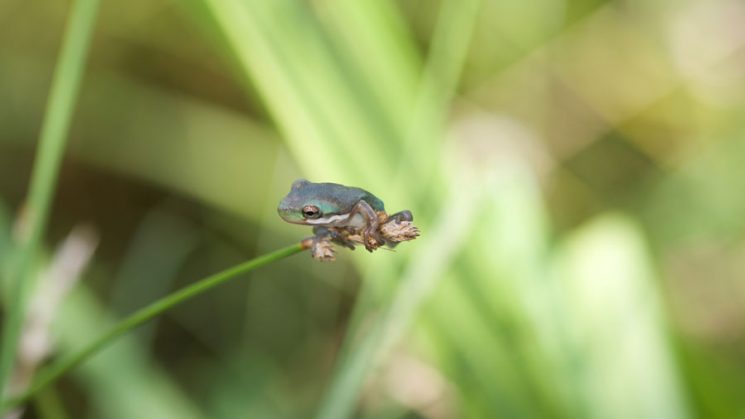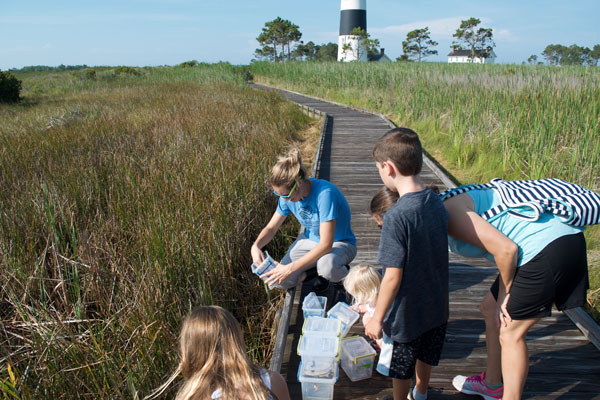
ABOVE: Coastal green treefrogs are showing an ability to adapt to an increasingly saline environment. Photo by Molly Albecker
In ecological terms, frogs are considered “indicator species.” Their presence implies that a wetland is healthy.
How is that, you ask?
Frogs have very thin skin that allows water from the surrounding environment to be absorbed into the body of the frog. Thus, if toxins are in a wetland, they are also likely in the frogs that inhabit that wetland.
Although we do not typically consider salt a toxin, saltwater is traditionally regarded to be lethal to frogs and many other species. Therefore, scientists have expected that because salt is so deadly to frogs, progressively rising sea levels, coastal erosion and storm surges will purge frogs — and other freshwater plants and animals — from coastal wetlands that are becoming increasingly saline.
Thus, the absence of frogs would be the new indicator of saltwater contamination.
Considering this pessimistic forecast for amphibians, Mike McCoy, my doctoral advisor at East Carolina University, and I set out on a frog survey. By documenting frog populations across the state’s outer and inner banks, we could identify species that live along the coast. Of those, we would note populations at highest risk of saltwater inundation.
Late one rainy night during summer 2014, I was slowly driving along the slick road leading to Bodie Island Lighthouse. I was employing a classic herpetological survey technique: hanging my head out the window listening for frog choruses.
I heard the characteristic dull roar of a large chorus of males calling to attract females in the distance. So, I hopped out to investigate where the sound was coming from, but was blocked by a dense thicket of brambles, shrubs and thorns.

A family stops to watch me release frogs back into the marsh around Bodie Island Lighthouse. Photo courtesy Molly Albecker
The next day Mike joined me. He, too, has been catching and studying frogs for much of his life. When I suggested that we should go back to Bodie Lighthouse to find the frogs I had heard the night before, he looked at me skeptically. “You know that’s a salt marsh back there, right?”
That was his subtle way of saying, “You’re hearing things. Frogs don’t live in salt marshes.” Nonetheless, he accompanied me out to the marsh.
Just minutes after stepping foot in the marsh, we heard a nearby green treefrog give a raspy call. I dipped my salinity meter into the water, and was shocked to see it flash “23.2” parts per thousand (ppt) or 66 percent seawater.
The highest salinity in which frogs have been observed in North America is 15 ppt — but this was 8 ppt above that record.
As we discussed how surprised we were, I watched fish dart around my submerged boots, including one swimmer that looked a little odd. Looking closer, I realized it was not a fish but a healthy, late-stage tadpole, swimming in the 23-ppt water like it was no big deal.
We returned to this wetland later in the summer and saw hundreds upon hundreds of green treefrogs living and breeding in highly salty water with no apparent issues. This was completely unexpected. Large populations of frogs are not supposed to occur in areas with toxins or contaminants like salt. Yet there they were. Perhaps, these frogs were indicating something else.
With that discovery — and critical funding from North Carolina Sea Grant — I began conducting experiments to uncover how these frogs can live in coastal salt marshes, and perhaps most important, what their presence means for the future of coastal frog populations.
I found that in many ways, coastal frogs are not very different from their inland counterparts that have not been exposed to saltwater. They eat similar diets. They have a similar community of bacteria living on their skin. They are the same size, and the same color.
However, we found several key differences in the coastal frogs.
Coastal frogs lay more of their eggs in saltwater compared to inland females. This gambit pays off as more coastal eggs hatch successfully in saltwater compared to inland eggs. In moderately high salinities of about 12 ppt, tadpoles from coastal parents have a 25 percent higher survival rate than tadpoles from inland parents. In addition, coastal tadpoles metamorphose — or change from tadpoles to froglets — about a week faster than inland tadpoles, regardless of salinity.
Even when we control for alternative explanations that could drive divergent responses, distinct differences between coastal and inland frogs still emerge. These repeated findings indicate one solid fact: Coastal green treefrogs have evolved to tolerate saltwater.
To follow up on the findings from our initial Sea Grant project, we have several ongoing studies to better understand this phenomenon. My funding comes from the National Science Foundation Doctoral Dissertation Improvement Grant, Graduate Women in Science Nell Mondy Fellowship, Garden Club of America Scholarship, Pitt County Wildlife Club Scholarship, and a Garden Club of America Scholarship.
One project examines these frogs at a cellular level to illuminate how internal machinery differs between coastal and inland frogs exposed to different levels of saltwater. Another project uses mathematical modeling to explore how saltwater exposure at different life stages — for example, tadpole or egg — might affect whether the population will go extinct.
So far, our results suggest that climate change and increasing salinity in freshwater wetlands may not be the death knell of coastal frogs that we once thought. In particular, green treefrogs show an ability to adapt to higher salinities — and that evolution could rescue some coastal populations from extinction.
However, it is still too early to pop celebratory champagne bottles. Much remains to be known about green treefrogs and the other species along our coast.
Nevertheless, frogs continue to serve as an indicator species — indicators of hope.
Learn — and see — more about this research as an online extra in the WRAL documentary package, Sea Change. Scroll down to see the video story.
Also, my Sea Grant-funded research and related environmental education outreach, was featured in Coastwatch magazine, “Leaping Out of the Lab.”
Molly Albecker is a doctoral candidate in the biology department at East Carolina University. She has a background working with reptiles and amphibians, and holds a master’s degree in biology also from ECU.